Saint Barthélemy
| Collectivity of Saint Barthélemy
Collectivité de Saint-Barthélemy
|
||||||
|---|---|---|---|---|---|---|
|
||||||
| Anthem: La Marseillaise |
||||||
|
|
||||||
| Capital (and largest city) |
Gustavia | |||||
| Official language(s) | French | |||||
| Local languages | Saint-Barthélemy French, Antillean Creole, English | |||||
| Ethnic groups | European, Mulatto, West African, Mestizo (French-East Asia)[1] | |||||
| Government | ||||||
| - | President of France | Nicolas Sarkozy | ||||
| - | Prefect | Dominique Lacroix | ||||
| - | President of the Territorial Council | Bruno Magras | ||||
| - | Deputy | Victorin Lurel | ||||
| - | Senator | Michel Magras | ||||
| Overseas Collectivity | of France | |||||
| - | French colony | 1648 | ||||
| - | Sold to Sweden | 1 July 1784 | ||||
| - | Sold to France | 16 March 1878 | ||||
| - | as separate Overseas Collectivity | 22 February 2007 | ||||
| Area | ||||||
| - | Total | 21 km2 (not ranked) 8.1 sq mi |
||||
| - | Water (%) | negligible | ||||
| Population | ||||||
| - | July 2009 estimate | 7,448[1] (226th) | ||||
| - | Jan. 2007 census | 8,450[2] | ||||
| - | Density | 354.7/km2 (26th) 919.5/sq mi |
||||
| HDI (2003) | n/a (unranked) (n/a) | |||||
| Currency | Euro (€) (EUR) |
|||||
| Time zone | AST (UTC-4) | |||||
| Internet TLD | .bl assigned but not in use, .fr and .gp in use | |||||
| Calling code | 590 | |||||
Saint Barthélemy (French: Saint-Barthélemy, French pronunciation: [sɛ̃baʁteləmi]; Swedish: Sankt Barthelemy), officially the Collectivity of Saint Barthelemy (French: Collectivité de Saint-Barthélemy), is an overseas collectivity of France. Often abbreviated to Saint-Barth in French, or St. Barts in English, the collectivity is one of the four territories among the Leeward Islands in the northeastern Caribbean that comprise the French West Indies, along with Guadeloupe, Martinique and Saint Martin.
St. Barts has an area of 21 km² and a population of 8,398 (census 2006). Its capital is Gustavia, which is also its main harbor. St Barts lies southeast of Sint Maarten/Saint Martin and north of St Kitts. It is the only Caribbean island to have historically been a Swedish colony for any significant length of time (Guadeloupe only having been one briefly, at the end of the Napoleonic Wars). Symbolism from the Swedish national arms, the three crowns, still appears in the island's coat of arms. The language, cuisine and culture are distinctly French.
Contents |
Economy
The official currency of Saint Barthélemy is the euro.
INSEE estimated that the total GDP of Saint Barthélemy amounted to 179 million euros in 1999 (US$191 million at 1999 exchanges rates; US$255 million at Oct. 2007 exchange rates).[3] In that same year the GDP per capita of St. Barts was 26,000 euros (US$27,700 at 1999 exchanges rates; US$37,000 at Oct. 2007 exchange rates), which was 10% higher than the average GDP per capita of metropolitan France in 1999.[3] Tourism explains in a large measure the very high standard of living on the island.
Tourism
St. Barts has long been considered a playground of the rich and famous and is known for its beautiful pristine beaches, gourmet dining in chic bistros and high-end designers.
St. Barts has about 25 hotels, most of them with 15 rooms or fewer. The largest has 58 rooms. Hotels are classified in the traditional French manner 3 Star, 4 Star and 4 Star Luxe.
Most of the rooms allocated to tourism on St Barts are found in private villas. There are approximately 400 privately owned villas available for rent on the island.
History
Saint Barthélemy was first claimed by France, in 1648. It was given to Sweden in 1784 (in exchange for trade rights in Gothenburg), which sold it back to France in 1878.
Slavery was practiced in St. Barts under the "Ordinance concerning the Police of Slaves and free Coloured People"[4] of 1787. The last legally owned slaves in the Swedish colony of St. Barts were bought free by the state on 9 October 1847.[5] The Swedish period left its mark in the names of many of the streets and the town Gustavia (in honor of King Gustav III), and the presence of Sweden's national arms, the Tre Kronor in the island's coat of arms.
Geography
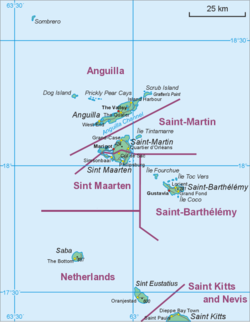
Map showing location of Saint Barts relative to Sint Maarten/Saint Martin and St Kitts
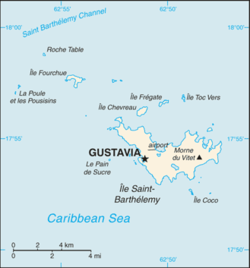
Map of Saint-Barthélemy
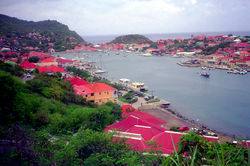
View of Gustavia Harbour

Gustavia Harbour, St. Barth
|
Located approximately 250 km east of Puerto Rico and the nearer Virgin Islands, Saint Barthélemy lies immediately southeast of the islands of Saint Martin and Anguilla. It is separated from Saint Martin by the Saint-Barthélemy Channel. It lies northeast of Saba and St Eustatius, and north of St Kitts. Some small satellite islets also belong to St. Barts:
- Île Chevreau (Île Bonhomme)
- Île Frégate
- Île Toc Vers
- Île Tortue
- Gros Îlets (Îlots Syndare)
Gustavia, which is the main town of the island, was named after King Gustav III of Sweden, and remains as a reflection of the Swedish period.
The oldest settlement still remaining is the village of Lorient (or L'Orient). Lorient's sister village on the French mainland is the city of Lorient on the southern coast of Brittany. The population is spread among a number of quartiers, roughly corresponding to settlements. Besides the capital Gustavia, there are:
- Anse des Cayes
- Grand Fond
- Grand Cul-de-Sac
- Petit Cul-de-Sac
- Quartier de Colombier
- Quartier de la Grande Saline
- Quartier de la Petite Saline
- Quartier de Public
- Quartier de Toiny
- Quartier des Flamands et Merlette
- Quartier du Corossol
- Quartier du Marigot
- Quartier du Roy
- Quartier de Vitet
- Quartier de Devé
- Quartier de Lurin
- Quartier de Gouverneur
- Quartier Lorient (oldest settlement)
- Quartier Saint-Jean
Beaches
Of the 21 beaches on the small island, several are considered especially inviting. On the southern side of the island, Saline is a pristine beach with no development. On the western edge of the island is Colombier beach, which is only reachable by boat or a hike. St. Jean, Flamands and Grand-Cul-de-Sac beaches are also popular and attractive beaches which have hotels and other establishments on them. Shell Beach is popular for families with children as it has little surf.
St. Barts has a tidal difference of only 8–15 cm. The beaches vary according to ocean currents — the weather travels onto the island following the sun from the East. One of the main surfing beaches (Toiny) is known for its riptide, while Grand Fond is one of the island's only non-swimming beaches. These is a small variety of warm water sharks in the Caribbean; swimming at dusk and dawn or in murky waters is not recommended. Otherwise, scuba and snorkeling are a great way to see the nurse sharks, lobsters, conch and green sea turtles that abound in the waters surrounding St. Barts.
The beach of Grand Cul-de-Sac is the easiest beach in the Caribbean for learning sailing, windsurfing and kitesurfing as it has a reef which closes off the entire bay. The current that passes outside the reef here also carries the migrating whales and dolphins.
Climate
Demographics
According to the January 2007 census, the population of St. Barths is 8,450 inhabitants,[2] with a population density of 402 inh. per km² in 2007 and caucasian islanders in the large majority. Most of the population are French-speaking descendants of the first settlers.
Many of the full-time residents are French citizens who work at the various establishments on the island. French is the primary language spoken, in standard form as well as the native dialects, Saint-Barthélemy French patois and Antillean Creole. English is increasingly the language of hotels and restaurants, although a small population of Anglophones has been resident in Gustavia for many years. The Saint-Barthélemy French patois is spoken in the leeward portion of the island and is superficially related to Quebec French,[6] whereas Creole French is limited to the windward side. Unlike other populations in the Caribbean, language preference between the Creole and Patois is geographically determined, and not racially.[7]
| 1766 | 1785 | 1812 | 1885 | 1961 | 1967 | 1974 | 1982 | 1990 | 1999 | 2007 |
|---|---|---|---|---|---|---|---|---|---|---|
| 327 | 950 | 5,482 | 2,600 | 2,176 | 2,351 | 2,491 | 3,059 | 5,038 | 6,852 | 8,450 |
| Official figures from French and Swedish censuses. | ||||||||||
Politics and government
| Saint Barthélemy |
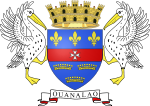 This article is part of the series: |
|
|
|
|
Other countries · Atlas |
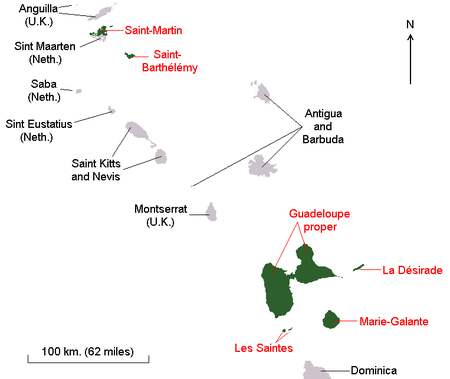
Until 2007, administratively, the whole island of Saint Barthélemy was a French commune (commune de Saint-Barthélemy) part of Guadeloupe, which is an overseas région and overseas département of France, and therefore part of the European Union. In 2003, the population voted in favour of secession from Guadeloupe in order to form a separate overseas collectivity (COM) of France.[8] On 7 February 2007,[9] the French Parliament passed a bill granting COM status to both St. Barts and neighbouring Saint Martin. The new status took effect on 22 February 2007, when the law was published in the Journal Officiel.[10] St. Barts remains part of the European Union.[11]
| Parties | Votes | % | Seats | ||||
|---|---|---|---|---|---|---|---|
| Saint Barth First!/UMP (Saint-Barth d’abord!, Bruno Magras) | 2,399 | 72.23 | 16 | ||||
| All United for Saint Barthélemy (Tous unis pour St-Barthélemy, Karine Miot-Richard) | 330 | 9.94 | 1 | ||||
| Action Balance and Transparence (Action Equilibre et Transparence, Maxime Desouches) | 330 | 9.94 | 1 | ||||
| Together for Saint Barthélemy (Ensemble pour St-Barthélemy, Benoît Chauvin) | 262 | 7.89 | 1 | ||||
| Total | 3,321 | 100.0 | 19 | ||||
| Source: RFO | |||||||
Transportation
St. Barts has a small airport known as Gustaf III Airport (IATA: SBH, ICAO: TFFJ) that is served by small regional commercial aircraft and charters. Most visiting aircraft carry fewer than twenty passengers, such as the Twin Otter, a common sight around St. Barts and throughout the northern West Indies. The short airstrip is at the base of a gentle slope ending directly on the beach at St Jean. The arrival descent is over the hilltop traffic circle and departing planes fly right over the heads of sunbathers on St. Jean Beach (although small signs advise sunbathers not to lie directly at the end of the runway). Due to the close proximity of arriving and departing planes, either location is ideal for viewing by aircraft enthusiasts. The nearest commercial jet airport is on the neighboring island of Saint Martin: Princess Juliana International Airport (IATA: SXM, ICAO: TNCM).
Ferries to and from Saint Martin are the only other real option (although the passage from Saint Martin to St. Barts is often rough), unless one is arriving by private charter boat or yacht.
Symbols
The island's coat of arms reflect its multinational history, containing the Swedish Three Crowns, along with the Maltese cross, the Fleur-de-lis, the mural crown, two pelicans, and the island's supposed Amerindian name Ouanalao.
Sports
The junior national French surf champion from Lorient, was named recently in the winner of 2006.
See also Rugby union in Saint Barthélemy.
Modeling
The tropical location and natural beauty of St. Barts makes it a prime location for modeling photo shoots, particularly for swimwear publications such as the Sports Illustrated Swimsuit Edition, which featured the island in its 1991 edition. St. Barts was also the location of Brande Roderick's 2001 Playmate of the Year pictorial for Playboy, and Victoria's Secret.
See also
- Index of Saint Barthélemy-related articles
References
- ↑ 1.0 1.1 World factbook Saint Barthelemy
- ↑ 2.0 2.1 (French) INSEE. "Résultats de l'enquête de recensement pour les communes de moins de 10 000 habitants enquêtées en 2004, en 2005, en 2006 ou en 2007". http://www.insee.fr/fr/recensement/nouv_recens/resultats/repartition/comd971.htm?numdep=971&x=33&y=10#S. Retrieved 16 January 2008.
- ↑ 3.0 3.1 (French) INSEE, CEROM. "Estimation du PIB de Saint-Barthélemy et de Saint-Martin" (PDF). http://www.insee.fr/fr/insee_regions/guyane/publi/PIB_IDN.pdf.
- ↑ Ordinance concerning the Police of Slaves and free Coloured People. Source: 'Mémoire St Barth', Saint-Barthélemy. Memoirestbarth.com; Francine M. Mayer, and Carolyn E. Fick, "Before and After Emancipation: Slaves and Free Coloreds of Saint-Barthelemy (French West Indies) in The 19th Century." Scandinavian Journal of History 1993 18 (4): 251-273.
- ↑ « 9 octobre » (1847) Source: 'Mémoire St Barth', Saint-Barthélemy. Memoirestbarth.com (French).
- ↑ Wittmann, Henri. Grammaire comparée des variétés coloniales du français populaire de Paris du 17e siècle et origines du français québécois. Le français des Amériques, ed. Robert Fournier & Henri Wittmann, 281-334. Trois-Rivières: Presses universitaires de Trois-Rivières, 1995;
- ↑ CALVET, Louis-Jean et Robert Chaudenson. Saint-Barthélemy: une énigme linguistique, Paris, CIRELFA, Agence de la Francophonie, 1998, 165 p.
- ↑ "French Caribbean voters reject change". Caribbean Net News. 9 December 2003. http://www.caribbeannetnews.com/2003/12/09/voters.htm. Retrieved 9 February 2007. "However voters on the two tiny French dependencies of Saint Barthélemy and Saint Martin, which have been administratively attached to Guadeloupe, approved the referendum and are set to acquire the new status of "overseas collectivity"."
- ↑ Magras, Bruno (16 February 2007). "Letter of Information from the Mayor to the residents and non-residents, to the French and to the foreigners, of Saint Barthélemy" (PDF). St. Barth Weekly. p. 2. http://www.st-barths.com/jsb/pdf_files/weekly108.pdf. Retrieved 18 February 2007. "On 7 February of this year, the French Parliament adopted the law granting Saint Barthélemy the Statute of an Overseas Collectivity."
- ↑ Legifrance.gouv.fr, Détail d'un texte. (French)
- ↑ "Treaty of Lisbon, Article 2, points 287 and 293". http://eur-lex.europa.eu/LexUriServ/LexUriServ.do?uri=OJ:C:2007:306:0042:0133:EN:PDF. Retrieved 31 January 2008.
Bibliography
External links
- Government
- Collectivity of Saint Barthélemy (Official government website) (French)
- Comité Territorial du Tourisme (Tourism board website) (French)
- Historical and botanical information
- Mémoire St Barth : Saint-Barthelemy's history (slave trade, slavery, abolitions)
- Histoire et aménagement linguistique à Saint-Barthélemy (French)
- Saint Barth Fauna & Flora (French)
- General information
- St. Barths Online: visitor's guide (English) (French)
- Hello-StBarth.com tourism guide about St Barts (English) (French)
- Saint Barthelemy entry at The World Factbook
- Saint Barthélemy at the Open Directory Project
- Wikimedia Atlas of Saint Barthélemy
- Saint Barthélemy travel guide from Wikitravel
- SBHonline Insiders Guide and forum (English)
- Directories
- www.StBarthsRestaurants.tel : St-Barts restaurants directory, complete and mobile
- www.StBarthsHotels.tel : St-Barts hotels directory, complete and mobile
|
|||||||||||||||||||||||||||||||||||||
|
|||||||||||||||||||||||||
|
||||||||||||||||||||||||||||||||||||||||
|
|||||||||||||||||||||||||||||||||||||
|
||||||||||
|
||||||||||||||
|
||||||||||||||
|
||||||||||||||
|
||||||||||||||
|
||||||||||||||


